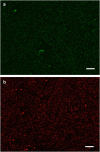Effect of Heat-Inactivated Clostridium sporogenes and Its Conditioned Media on 3-Dimensional Colorectal Cancer Cell Models
- PMID: 26507312
- PMCID: PMC4623472
- DOI: 10.1038/srep15681
Effect of Heat-Inactivated Clostridium sporogenes and Its Conditioned Media on 3-Dimensional Colorectal Cancer Cell Models
Abstract
Traditional cancer treatments, such as chemotherapy and radiation therapy continue to have limited efficacy due to tumor hypoxia. While bacterial cancer therapy has the potential to overcome this problem, it comes with the risk of toxicity and infection. To circumvent these issues, this paper investigates the anti-tumor effects of non-viable bacterial derivatives of Clostridium sporogenes. These non-viable derivatives are heat-inactivated C. sporogenes bacteria (IB) and the secreted bacterial proteins in culture media, known as conditioned media (CM). In this project, the effects of IB and CM on CT26 and HCT116 colorectal cancer cells were examined on a 2-Dimensional (2D) and 3-Dimensional (3D) platform. IB significantly inhibited cell proliferation of CT26 to 6.3% of the control in 72 hours for the 2D monolayer culture. In the 3D spheroid culture, cell proliferation of HCT116 spheroids notably dropped to 26.2%. Similarly the CM also remarkably reduced the cell-proliferation of the CT26 cells to 2.4% and 20% in the 2D and 3D models, respectively. Interestingly the effect of boiled conditioned media (BCM) on the cells in the 3D model was less inhibitory than that of CM. Thus, the inhibitive effect of inactivated C. sporogenes and its conditioned media on colorectal cancer cells is established.
Figures







References
-
- Siegel R., Ma J., Zou Z. & Jemal A. Cancer statistics, 2014. CA Cancer J. Clin. 64, 9–29 (2014). - PubMed
-
- Razik R. et al. Long-term outcomes following resection of retroperitoneal recurrence of colorectal cancer. Eur. J. Surg. Oncol. 40, 739–746 (2014). - PubMed
-
- Veldkamp R. et al. Laparoscopic surgery versus open surgery for colon cancer: short-term outcomes of a randomised trial. Lancet Oncol. 6, 477–484 (2005). - PubMed
-
- Helmlinger G., Yuan F., Dellian M. & Jain R. K. Interstitial pH and pO2 gradients in solid tumors in vivo: high-resolution measurements reveal a lack of correlation. Nat. Med. 3, 177–182 (1997). - PubMed
-
- Höckel M. & Vaupel P. Tumor hypoxia: definitions and current clinical, biologic, and molecular aspects. J. Natl. Cancer Inst. 93, 266–276 (2001). - PubMed
Publication types
MeSH terms
Substances
LinkOut - more resources
Full Text Sources
Other Literature Sources
Medical
Research Materials

